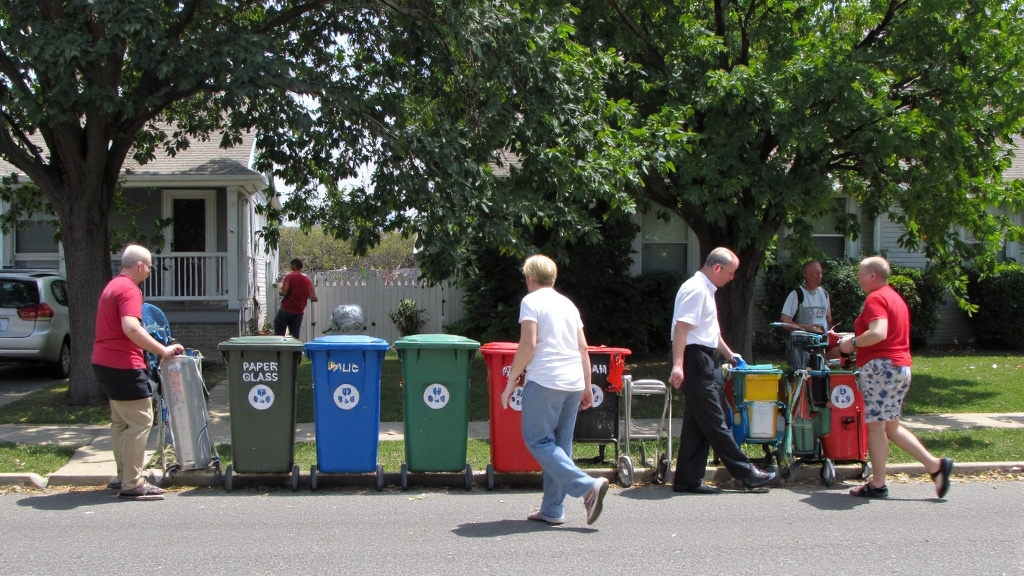5901 Botham Jean Blvd, Dallas, TX 75215
How to Start a Scrap Drop-off Program: An Introduction
April 29, 2025Americans send over 9 million tons of metal to landfills each year. This material could be recycled instead, conserving natural resources and reducing environmental impact. Establishing a scrap drop-off program in your community provides a practical solution to this waste issue while creating economic opportunities.
Such a program offers designated locations where residents can bring unwanted metal items for recycling. These initiatives divert valuable materials from landfills, transforming them into resources for manufacturing new products. The environmental benefits include reduced energy consumption, decreased mining of raw materials, and lower greenhouse gas emissions.
Beyond environmental advantages, scrap metal recycling strengthens local economies by creating jobs in collection, processing, and manufacturing. Your community can develop a successful scrap drop-off program through strategic planning, partnerships with recycling centers, and active community engagement.
With proper implementation, residents will embrace this initiative as both an environmental responsibility and a practical way to dispose of unwanted items.
How Can You Make Scrap Collection Convenient and Accessible?

Convenience is key to any successful scrap collection program. Strategic location selection greatly impacts participation rates and overall program effectiveness. When planning drop-off points, prioritize large, open areas that accommodate vehicles of various sizes and allow for quick, hassle-free drop-offs.
Strategic Location Selection
Community-centered locations offer great potential for program success. Schools, churches, community centers, and public spaces naturally attract regular traffic and provide the visibility necessary for sustained participation. These familiar settings also help normalize recycling behaviors within the community.
Municipal partnerships can significantly enhance location options. Several successful programs partner with local governments to establish drop spots at town transfer stations where residents already visit for waste disposal. This integration makes recycling a natural extension of existing habits rather than an additional task.
Accessibility Considerations
True accessibility extends beyond mere convenience. Consider proximity to public transportation routes to serve residents without personal vehicles. Ensure all collection points comply with ADA standards, featuring smooth paths, appropriate ramp access, and obstacle-free drop-off zones.
Physical layout matters tremendously for user experience. Position collection containers in easily visible locations with sufficient space for multiple users simultaneously. The Hoboken city program demonstrates this principle through strategically placed drop spots throughout the community, maximizing convenience for all residents.
Clear Communication Elements
Even perfectly located drop-off points fail without proper communication tools. Install prominent, weather-resistant signage with simple instructions and clear visuals showing acceptable materials. Color-coding collection bins further simplifies the process for users navigating multiple material streams.
Consistent operational hours build reliability into your program. Residents develop recycling habits based on predictable access. Weekend and evening availability proves especially important for working professionals who cannot visit during standard business hours.
Digital communication complements physical signage. Consider developing mobile applications like the CompostHere program that helps users easily locate and access stations through a single interface while providing real-time updates about operational hours and accepted materials.
- Optimal location factors include high visibility, easy vehicle access, proximity to existing traffic patterns, and adequate space for multiple users.
- Accessibility requirements should address public transportation proximity, ADA compliance, and intuitive site layout.
- Communication elements should feature clear signage, consistent hours, and supporting digital tools.
- Partnership opportunities with local organizations can expand location options and community reach.
The Town of Saugerties exemplifies effective location strategy by positioning their drop spot at the existing town transfer station. This integration leverages established waste disposal habits, making scrap recycling a convenient extension rather than a separate errand. The clearly marked area features consistent hours aligned with transfer station operation, maximizing accessibility for residents already visiting the facility.
The physical design of drop-off points significantly impacts user experience. Ensure adequate turning radius for vehicles, minimize wait times through efficient layout, and provide weather protection where feasible. These thoughtful details encourage repeat participation and positive program perception.
| Key Factor | Description |
|---|---|
| Minimize Pedestrian-Vehicle Interaction | Designate separate drop-off zones away from heavy pedestrian traffic, ensuring crosswalks and walkways are visible and well-lit. |
| Clear Zone Delineation | Clearly mark and define the drop-off process and student loading areas. |
| Adequate Dimensions | Ensure drop-off areas have adequate width and length to accommodate vehicle movement safely. Typical dimensions are based on parking lot sizes. |
| Strategic Location | Position drop-off points at least 30 meters away from bus stops, road junctions, and pedestrian crossings to ensure smooth traffic flow. |
| Accessibility | Comply with ADA standards, ensuring smooth paths and ramp access for all users. |
| Communication Tools | Install clear signage with instructions and use digital tools for real-time updates. |
What Strategies Can Educate and Motivate Participants?
Education is crucial for a successful scrap drive. Clear information about which materials to collect helps participants focus their efforts and understand their impact. Simple visual guides with images and descriptions of acceptable items prevent contamination issues common in recycling initiatives.
Color-coding systems significantly reduce confusion at collection points. Assign specific colors to different metal categories—blue bins for aluminum, red for copper, and gray for steel. This visual method helps participants quickly identify where materials belong without needing to read detailed instructions.
Develop accessible educational materials explaining the recycling process from collection to processing. Short videos showing how metals are transformed after collection help participants understand why proper sorting matters. Include concrete statistics about environmental benefits, such as how recycling one ton of steel conserves 2,500 pounds of iron ore and 1,400 pounds of coal.
Interactive learning approaches turn education into engagement. A ‘Metal Detective’ game can make learning enjoyable—participants use magnets, visual cues, and simple tests to identify different metal types. Each correct identification earns points, with small prizes for reaching certain thresholds. This is effective with families and school groups who might find recycling education dry.
Friendly competition boosts engagement in scrap drives. Set up contests between neighborhoods, schools, or community groups to see who can collect the most scrap metal. Track progress visibly through physical leaderboards at collection sites or digital dashboards online. Consider offering meaningful rewards to winning teams, such as funding for community improvement projects.
Organize hands-on workshops teaching participants how to identify valuable metals in everyday items. Demonstrate how to safely prepare materials for recycling, such as removing insulation from copper wire or separating mixed materials. These practical skills empower participants to become more effective collectors.
Schedule workshops before main collection events to properly prepare participants. Record these sessions for those who cannot attend in person and share them through community channels to reach a wider audience.
By implementing these educational strategies, your scrap drive will attract more knowledgeable participants who collect higher-quality materials, resulting in better environmental outcomes and potentially higher financial returns for your community recycling initiative.
| Type of Metal | Examples | Recyclability |
|---|---|---|
| Ferrous Metals | Iron, Steel | Highly recyclable; often used in construction and manufacturing. |
| Non-Ferrous Metals | Aluminum, Copper, Brass, Lead | Recyclable; used in various industries including automotive and electronics. |
How Can Community Involvement Boost Scrap Drive Success?

Community involvement is crucial for successful scrap drive initiatives. When residents unite around environmental goals, participation rates increase and collection volumes grow significantly. Strategic engagement turns occasional participants into committed environmental stewards.
Creating a dedicated recycling club establishes a foundation for ongoing community efforts. These clubs drive scrap initiatives through organization, education, and enthusiasm. Members receive training on proper sorting techniques and material identification, becoming knowledgeable ambassadors who guide others through the recycling process.
Setting Clear, Measurable Goals
Clear objectives provide community members with tangible targets. Start with baseline metrics like current recycling rates or typical collection volumes, then set ambitious yet realistic goals that challenge without causing discouragement.
Goals might include collecting specific amounts of materials, reaching participation percentages across neighborhoods, or achieving certain diversion rates from landfills. Public tracking methods—such as progress charts in community centers or digital dashboards on local websites—create visibility and build momentum.
Community-wide incentives significantly boost participation when tied to these goals. Consider funding community improvement projects with scrap drive proceeds or implementing recognition programs for neighborhoods with the highest participation rates.
Leveraging Volunteer Engagement
Volunteers transform scrap drives from routine collection events into vibrant community activities. Their enthusiasm and personal connections encourage participation from residents who might otherwise ignore recycling initiatives. Volunteers also provide essential labor, making large-scale collection both possible and cost-effective.
Create varied volunteer roles to accommodate different skills and availability. Collection site monitors help residents properly sort materials, reducing contamination issues. Drivers and pickup teams assist elderly or disabled residents with transporting materials. Educational ambassadors conduct workshops on proper recycling practices before and during events.
Collaborating with Local Government
Municipal partnerships elevate scrap drives from isolated events to integrated components of community waste management. Local government collaboration provides legitimacy, resources, and broader reach for recycling initiatives.
When approaching local officials, come prepared with specific requests and clear benefits. Most municipalities welcome community-led environmental efforts that align with sustainability goals and reduce waste management costs. Government partners can provide public spaces for collection events without permit fees, offer waste management expertise, and create promotional opportunities through official channels.
In San Francisco, this collaborative approach helped the city achieve over 80% diversion from landfills. The partnership between residents, community organizations, and local government created a comprehensive program that transformed how the city approaches waste management.
Creating Sustainable Engagement
One-time events generate initial excitement, but sustainable scrap drive success depends on consistent community involvement. Building ongoing engagement requires regular communication, visible progress, and opportunities for deeper participation.
Educational workshops help residents understand why materials are valuable and how proper recycling benefits everyone. These sessions transform abstract environmental concepts into concrete actions that motivate continued participation.
Regular recognition of volunteers and participants sustains momentum between collection events. Simple acknowledgments in community newsletters or social media posts validate efforts and inspire others to join the cause.
By fostering genuine community ownership of recycling initiatives, scrap drives transition from occasional events to integral parts of community identity. This transformation creates lasting environmental impact through sustained material recovery and waste diversion.
| Benefit Type | Description |
|---|---|
| Economic Benefits | Creates jobs in collection, processing, and manufacturing sectors; reduces waste management costs by lowering landfill use. |
| Environmental Benefits | Reduces energy consumption, minimizes raw material extraction, and lowers greenhouse gas emissions. |
| Community Benefits | Fosters community engagement and responsibility; strengthens local economies through job creation and resource conservation. |
Conclusion: Transforming Scrap Drives into Community Success
A successful scrap drop-off program requires careful planning, dedicated community involvement, and ongoing education. By prioritizing convenience and accessibility, communities can establish programs that effectively divert significant waste from landfills. These initiatives not only reduce waste but also foster stronger, more environmentally conscious communities through shared responsibility and action.
Creating a thriving scrap program is more than an environmental initiative—it’s a community-building opportunity that delivers tangible results. The benefits go beyond waste diversion to include resource conservation, reduced greenhouse gas emissions, and enhanced community pride.
For professional guidance on establishing or improving your local scrap drop-off program, contact Okon Recycling at 214-717-4083.
